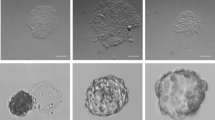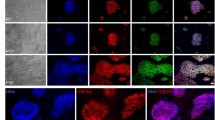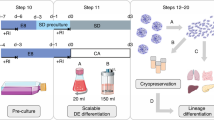Abstract
Realizing the potential of human embryonic stem cells (hESCs) in research and commercial applications requires generic protocols for culture, expansion and genetic modification that function between multiple lines. Here we describe a feeder-free hESC culture protocol that was tested in 13 independent hESC lines derived in five different laboratories. The procedure is based on Matrigel adaptation in mouse embryonic fiboblast conditioned medium (CM) followed by monolayer culture of hESC. When combined, these techniques provide a robust hESC culture platform, suitable for high-efficiency genetic modification via plasmid transfection (using lipofection or electroporation), siRNA knockdown and viral transduction. In contrast to other available protocols, it does not require optimization for individual lines. hESC transiently expressing ectopic genes are obtained within 9 d and stable transgenic lines within 3 weeks.
This is a preview of subscription content, access via your institution
Access options
Subscribe to this journal
Receive 12 print issues and online access
$259.00 per year
only $21.58 per issue
Buy this article
- Purchase on Springer Link
- Instant access to full article PDF
Prices may be subject to local taxes which are calculated during checkout


Similar content being viewed by others

References
Osafune, K. et al. Marked differences in differentiation propensity among human embryonic stem cell lines. Nat. Biotechnol. 26, 313–315 (2008).
Giudice, A. & Trounson, A. Genetic modification of human embryonic stem cells for derivation of target cells. Cell Stem Cell 2, 422–433 (2008).
Davis, R.P. et al. Targeting a GFP reporter gene to the MIXL1 locus of human embryonic stem cells identifies human primitive streak-like cells and enables isolation of primitive hematopoietic precursors. Blood 111, 1876–1884 (2008).
Urbach, A., Schuldiner, M. & Benvenisty, N. Modeling for Lesch-Nyhan disease by gene targeting in human embryonic stem cells. Stem Cells 22, 635–641 (2004).
Costa, M. et al. A method for genetic modification of human embryonic stem cells using electroporation. Nat. Protoc. 2, 792–796 (2007).
Zwaka, T.P. & Thomson, J.A. Homologous recombination in human embryonic stem cells. Nat. Biotechnol. 21, 319–321 (2003).
Draper, J.S. et al. Recurrent gain of chromosomes 17q and 12 in cultured human embryonic stem cells. Nat. Biotechnol. 22, 53–54 (2004).
Braam, S.R. et al. Improved genetic manipulation of human embryonic stem cells. Nat. Meth. 5, 389–392 (2008).
Liew, C.-G., Draper, J.S., Walsh, J., Moore, H. & Andrews, P.W. Transient and stable transgene expression in human embryonic stem cells. Stem Cells 25, 1521–1528 (2007).
Dormeyer, W. et al. Plasma membrane proteomics of human embryonic stem cells and human embryonal carcinoma cells. J. Proteome Res. 7, 2936–2951 (2008).
Ludwig, T.E. et al. Derivation of human embryonic stem cells in defined conditions. Nat. Biotechnol. 24, 185–187 (2006).
Ng, E.S., Davis, R., Stanley, E.G. & Elefanty, A.G. A protocol describing the use of a recombinant protein-based, animal product-free medium (APEL) for human embryonic stem cell differentiation as spin embryoid bodies. Nat. Protoc. 3, 768–776 (2008).
Wu, S., Ying, G., Wu, Q. & Capecchi, M.R. A protocol for constructing gene targeting vectors: generating knockout mice for the cadherin family and beyond. Nat. Protoc. 3, 1056–1076 (2008).
Kameda, T., Smuga-Otto, K. & Thomson, J.A. A severe de novo methylation of episomal vectors by human ES cells. Biochem. Biophys. Res. Commun. 349, 1269–1277 (2006).
Anderson, D. et al. Transgenic enrichment of cardiomyocytes from human embryonic stem cells. Mol. Ther. 15, 2027–2036 (2007).
Cowan, C.A. et al. Derivation of embryonic stem-cell lines from human blastocysts. N. Engl. J. Med. 350, 1353–1356 (2004).
Burridge, P.W. et al. Improved human embryonic stem cell embryoid body homogeneity and cardiomyocyte differentiation from a novel V-96 plate aggregation system highlights interline variability. Stem Cells 25, 929–938 (2007).
Mitalipova, M. et al. Human embryonic stem cell lines derived from discarded embryos. Stem Cells 21, 521–526 (2003).
Reubinoff, B.E., Pera, M.F., Fong, C.Y., Trounson, A. & Bongso, A. Embryonic stem cell lines from human blastocysts: somatic differentiation in vitro. Nat. Biotechnol. 18, 399–404 (2000).
Costa, M. et al. The hESC line Envy expresses high levels of GFP in all differentiated progeny. Nat. Meth. 2, 259–260 (2005).
Michaoska, A.E. Unit 1C.3 Isolation and propagation of mouse embryonic fibroblasts and preparation of mouse embryonic feeder layer cells. Curr. Protoc. Stem Cell Biol. 3, 1C.3.1–1C.3.17 (2007).
Baker, D.E.C. et al. Adaptation to culture of human embryonic stem cells and oncogenesis in vivo. Nat. Biotechnol. 25, 207–215 (2007).
Shapiro, H.M. Practical Flow Cytometry (Wiley Interscience, New York, 2003).
Brown, C.M. Fluorescence microscopy—avoiding the pitfalls. J. Cell Sci. 120, 1703–1705 (2007).
Acknowledgements
We are grateful to D. Ward-van Oostwaard, L. Zeinstra and S. van den Brink for expert technical assistance. We thank Drs Chad Cowan and Douglas Melton for the gift of HUES-1, -5, -7 and -15. This work is/has been supported by the Dutch Program for Tissue Engineering (S.R.B.), European Community's Sixth Framework Programme contract ('HeartRepair') LSHM-CT-2005-018630 (R.P.), the Biotechnology and Biological Sciences Research Council, British Heart Foundation and the University of Nottingham (C.D., E.M. and L.E.Y.).
Author information
Authors and Affiliations
Contributions
S.R.B. and C.D. contributed equally to this work.
Corresponding authors
Rights and permissions
About this article
Cite this article
Braam, S., Denning, C., Matsa, E. et al. Feeder-free culture of human embryonic stem cells in conditioned medium for efficient genetic modification. Nat Protoc 3, 1435–1443 (2008). https://doi.org/10.1038/nprot.2008.140
Published:
Issue Date:
DOI: https://doi.org/10.1038/nprot.2008.140
This article is cited by
-
Permissive epigenomes endow reprogramming competence to transcriptional regulators
Nature Chemical Biology (2021)
-
Robust protocol for feeder-free adaptation of cryopreserved human pluripotent stem cells
In Vitro Cellular & Developmental Biology - Animal (2019)
-
A fully defined static suspension culture system for large-scale human embryonic stem cell production
Cell Death & Disease (2018)
-
CDK1-PDK1-PI3K/Akt signaling pathway regulates embryonic and induced pluripotency
Cell Death & Differentiation (2017)
-
Precise and efficient scarless genome editing in stem cells using CORRECT
Nature Protocols (2017)
Comments
By submitting a comment you agree to abide by our Terms and Community Guidelines. If you find something abusive or that does not comply with our terms or guidelines please flag it as inappropriate.


